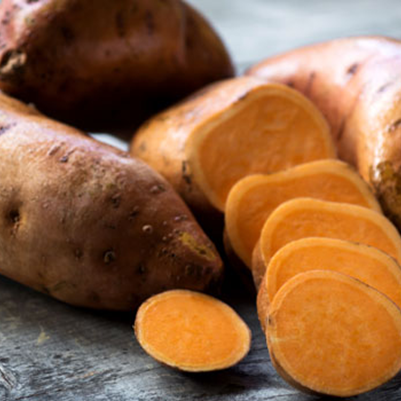
Rich in fibre, vitamins and minerals, find out why these starchy, sweet root vegetables are so good for you and discover the best ways to cook them.
What is a sweet potato?
The sweet potato is a starchy, sweet-tasting root vegetable. They have a thin, brown skin on the outside with coloured flesh inside – most commonly orange in colour, but other varieties are white, purple or yellow. You can eat sweet potatoes whole or peeled, and the leaves of the plant are edible too.
They may both be called 'potatoes', but sweet and white potatoes are not actually related. Botanically, the sweet potato belongs to the bindweed or morning glory family, whereas the white potato sits in the nightshade family.
Nutritional value of sweet potato
Sweet potatoes are a rich source of fibre as well as containing a good array of vitamins and minerals including iron, calcium, selenium, and they're a good source of most of our B vitamins and vitamin C. One of the key nutritional benefits of sweet potato is that they're high in an antioxidant known as beta-carotene, which converts to vitamin A once consumed.
Learn more about why we need fibre, vitamins and minerals.
80g of sweet potato, or about one medium potato, counts towards one of your five-a-day, unlike white potato which does not. Take a look at our infographic to find out what counts as 5-a-day.
Can sweet potatoes help reduce the risk of cancer?
While there are no single 'superfoods' that can prevent cancer and certain risk factors for cancer are unrelated to diet, there is evidence that eating a healthy diet can reduce the risk of cancer. Fruit and vegetables are high in antioxidants, compounds that help defend the body against damage by 'free radicals'. Studies have suggested that the antioxidants in the peel of sweet potatoes in particular, and especially purple sweet potato, may help reduce this oxidation process, thereby reducing the risk of cancer.
A study in Asia also found that diets high in vitamin-A vegetables, including sweet potato leaves, may provide potential protection from lung cancer.
Are sweet potatoes good for digestion?
Sweet potatoes are high in fibre, which has been shown to promote a healthy digestive system. Research so far has only been conducted on animals, but it would appear that the high phytosterol content of sweet potatoes does have a protective effect on the digestive system and may be important in the prevention and management of duodenal and gastric ulcers, including those due to NSAIDS (non-steroidal anti-inflammatory drugs such as ibuprofen).
Discover more digestive health recipes and tips.



